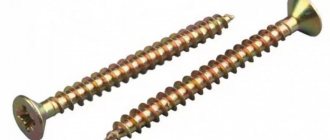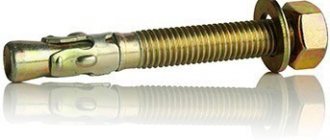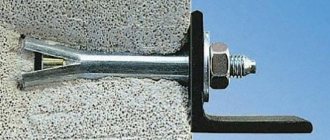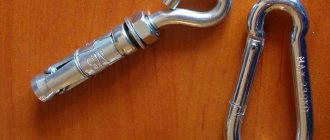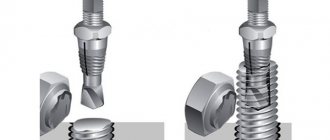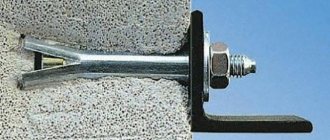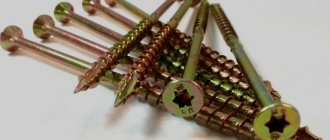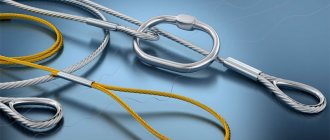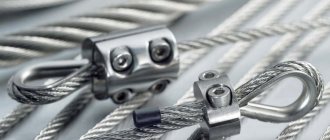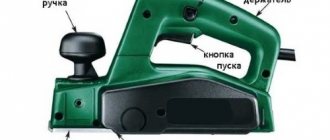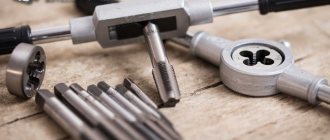Concrete is one of the most durable and hard materials. But this advantage of it used to be an obstacle to attaching heavy structures to it: wooden choppers and plastic dowels could not cope with the heavy load. Now this is not a problem; a special fastener has been developed for these purposes - a concrete anchor bolt. How to use such hardware, what they are, and by what criteria they are selected to solve a particular construction problem, it is worth understanding in detail.
The construction of concrete, brick and stone structures is impossible without the use of anchors Source shhaixilide.com
Mechanical anchors
The most common and inexpensive fastener for concrete, as well as other hard materials such as brick or natural stone, are mechanical anchors. They come in several types and differ from each other in the installation method and the type of adhesion to the base material. They are made from durable steel grades, stainless or treated with anti-corrosion compounds. Sometimes such products are called metal dowels.
For adhesion to hard and heterogeneous material, anchors are equipped with special threads, sleeves, collets, bushings and other additional elements that increase friction and prevent shifting, tearing out or bending of the fasteners.
How to secure an anchor bolt in concrete depends on the type of fastener and construction technology. Most of these hardware can be installed both in solid concrete and in liquid mortar before it begins to harden. Installation in mortar is usually used when pouring foundations and monolithic armored belts for subsequent fastening of walls and roofing structures to them.
Anchor bolts in foundation formwork Source gregvan.com
The anchor is fixed in the formwork by welding and tied to the reinforcement with wire. For reliability, its lower end is bent or a metal pad is welded onto it. The poured concrete tightly envelops the lower part of the hardware, there are no voids left between them, so after final hardening the adhesion is very reliable and immovable.
Advice! Before pouring the solution, wrap the anchors with film or tape to avoid clogging the threads.
Masking tape will protect the bolts from the mortar Source towerbuild.com
But the need to install fasteners in ready-made concrete structures arises much more often. To mount a flight of stairs, secure a canopy, decorate walls with façade panels, hang a boiler on a wall or a chandelier from the ceiling, different anchors are required. You need to be able to select them based on their design, base material and loads. Installation of any mechanical anchor in a concrete base requires pre-drilling of holes.
Note! The depth of the installation hole is made several millimeters greater than the length of the working part of the fastener, since concrete dust and debris remain in the well, which cannot be completely removed.
Spacers
The design of expansion anchors consists of a threaded rod and a short expansion sleeve or a long sleeve with slots and projections.
Expansion anchor bolt with sleeve Source stroyportal.ru
- One end of the rod is made in the form of a cone with a flared base, the other is threaded.
- The sleeve is put on the smooth part of the pin and rests against the cone.
- The movement of the sleeve towards the thread stops the restrictive ring.
- After installing the fastener into the hole, a nut is screwed onto the thread, and the pin wedges the sleeve, the petals of which begin to slide along the cone, opening and increasing the fit to the walls of the well and increasing the friction forces, thanks to which the anchor is firmly held in the concrete.
- The protrusions on the sleeve prevent it from turning when tightened.
This fastener is only suitable for hard concrete, since wedging creates quite large local bursting loads on the walls of the hole, which can be destructive for cellular concrete and other low-density materials. It is very popular, since it is quick to screw an anchor bolt into concrete, and the quality of fastening is high.
Another type of expansion anchor has a sleeve, the length of which is equal to the distance between the nut screwed onto the stud and the conical extension. The anchor bolt with a hex head instead of a cone is equipped with a long spacer nut with one ground edge.
The expansion anchor pin can end with a hook or ring for fastening suspended structures Source rubilnik.ru
The reliability of fastening with expansion anchors and their high load-bearing capacity is also ensured by the fact that they fit very tightly into the hole, since their diameters are the same. And the most reliable are double-expansion anchors. Instead of one long sleeve, two are put on the rod, which more evenly distributes internal stresses and provides support at the end and middle of the anchorage.
Double-expansion anchors can be used in medium-density concrete Source bricoman.pl
See also: Catalog of companies that specialize in the design and reconstruction of houses of any complexity
The installation process is as follows:
- in concrete, a hole of the same diameter as the rod is drilled with a hammer drill or impact drill;
- Remove debris generated during drilling from the hole using a vacuum cleaner, a special syringe or a rubber bulb;
- the anchor is inserted into the prepared well;
- since it fits in quite tightly, you can lightly tap it with a hammer through a wooden pad;
- A washer is placed on the protruding end, then the nut is screwed on with a wrench.
Sequence of installation of expansion anchor Source vsecuplu.ru
Wedge
Another name for a wedge anchor is a ceiling or wedge anchor. It is designed for attaching suspended structures to solid foundations without cracks. These are light suspended ceilings, metal slats and profiles, ventilation grilles and air ducts, cable systems.
Note! Wedge structures are non-removable, so marking must be done with high precision.
The main difference from spacer-type products is the absence of threads, since an anchor bolt can only be installed into concrete using a hammer. It consists of a rod with a locking head and a wedge-shaped spacer.
Wedge anchor for concrete Source allegroimg.com
- A rod 40-60 mm long has a longitudinal cut, which disappears towards the end, causing the leg of the rod to expand.
- A head in the form of a round plate with a hole for a wedge is welded onto the upper part of the rod.
- The cross section of the upper part of the spacer wedge is similar to the shape of the hole in the head. Under the head, the wedge is equipped with locking protrusions, and its end is tapered.
The anchor is inserted into the hole through the attached product and fixed with hammer blows on the protruding end of the wedge. Moving deeper, he slides along the beveled side of the rod and stands upright. When the wedge is completely driven into the cavity, only the flat head of the anchor remains on the surface.
Fastening perforated tape with a wedge anchor Source e-innovation.biz
Frame
A frame anchor bolt is a type of spacer product designed for fastening door and window frames into openings made of brick and concrete. A distinctive feature is a bushing cut along its entire length, in the upper part of which there are protrusions that prevent it from turning during installation. Instead of a nut or a hex head, there is a countersunk flat head with a Phillips slot for a screwdriver on the front side.
Frame anchor for securing door frames Source dropship-b2b.com.ua
The method for attaching anchor bolts to concrete is similar.
- Holes for frame bolts are drilled in the walls of the opening.
- Through holes of the same diameter are made in a wooden box.
- The total depth of the hole and the thickness of the box should be slightly greater than the length of the anchor.
- The box is placed in place until the holes in it and in the opening coincide.
- The bolt inserted into the hole is driven all the way and tightened with a screwdriver or screwdriver.
Since the sleeve expands entirely, the stress is distributed not over local areas, but evenly along the length, so this fastener is suitable for both dense and cellular concrete.
What is a concrete anchor bolt
Many have heard that to solve problems of fastening to the ceiling, internal and external surfaces of concrete walls, a special fastening element is used - an anchor bolt. Not everyone knows what it is. Let's try to figure out what an anchor is. This is a metal fastener that allows for reliable fastening of furniture, equipment and appliances on brick, stone, concrete and foam block surfaces, as well as on hollow panels and walls made of gas-filled blocks. The fastening element is installed in a hole with certain dimensions.
An anchor is a fixation device capable of absorbing significant forces due to the following factors:
- frictional forces, due to which the collet sleeve is held in the formed cavity;
- interaction forces of a special spacer mechanism with the inner surface of the channel;
- the adhesive characteristics of the adhesive ingredients located inside the drilled hole.
Among the many types of fixing devices, wedge-type anchors, as well as expansion anchors for concrete, are in high demand. Their design features and technical parameters allow the fixing element to increase the diameter of the working surface when decompressed inside the cavity. In this case, the magnitude of the friction force increases sharply. An anti-corrosion coating on the surface of such an element prevents the occurrence of corrosion and increases the service life.
Anchor bolt for concrete
Chemical anchors
A chemical anchor is an ideal way to attach various structures to cellular or hollow concrete. It is not in great demand for only one reason - the high cost of such products.
The principle of operation is based on creating a monolithic connection of the bolt body with the base material by pouring a liquid, quick-hardening two-component adhesive composition into the installation hole. Distributing along the entire length of the drilled hole and filling the pores and voids, the glue distributes the load as evenly as possible and makes the material at the attachment points more durable.
There are many types of chemical anchors on sale, differing in the composition of the adhesive mixture, release form, and installation methods. Metal hardware must be purchased separately.
- In everyday life, it is most convenient to use ampoule (capsule) anchors.
Ampoules are selected to match the diameter of the screw or stud. They are divided into two capsules, one of which contains the main adhesive composition, and the other contains the hardener. After installing the ampoule into the hole, the hardware is screwed directly into it, the shells of the capsules are torn, their contents are mixed and quickly harden.
At the end of the ampoule there is a recess for positioning the screw Source etm.ru
Tips for selection and installation
Which anchor is best for concrete depends on the density of the base material and the design load on the fastener. Incorrect selection risks damaging the connection. It is possible that the base itself may be destroyed, or the anchor may be bent or pulled out. The consequences in the form of a wind-blown roof, collapsed façade trim, or fallen kitchen cabinet are incommensurate with the cost of even the most expensive hardware.
If you have project documentation, you must strictly follow its instructions and use fasteners of recommended brands. The marking encodes such parameters as the diameter of the thread or sleeve of the anchor, its length, the diameter of the drill for making the installation hole, and the maximum thickness of the attached element.
In the absence of a design, fasteners are selected according to the technical characteristics indicated by the manufacturers in the table of basic parameters. These tables are compiled based on tests and contain information such as minimum pull-out force, maximum anchoring torque, and permissible bending moment.
Summary table of parameters for expansion anchors Source krep54plus.ru
The basic rule when choosing: the lower the density of the material, the larger the thrust area should be. And the heavier the structure being attached, the more powerful the fastener is needed. For example, short drive-in anchors can only be used for hard concrete.
Certain rules also exist for choosing the distance between attachment points. It must be no less than 4 times the length of the anchor, and when installed at the edge of a concrete base, no less than two of its lengths.
But in reality, it is not always possible to follow these recommendations. For example, the distance between mounting holes in brackets for hanging TVs and other household appliances is usually small. And sometimes you have to fasten parts close to the outer corner of the wall.
In such cases, it is recommended to select double-leaf expansion anchors and position them in the hole so that when wedged, they create an upward and downward load, rather than toward each other or toward the edge of the base.
Correct position of the anchor with a small step between the horizontal attachment points Source krepezhinfo.ru
There are no such restrictions for chemical anchors - they do not weaken the structure of the material, but, on the contrary, make it stronger.
Anchor bolt sizes for concrete
The diameter of the threaded part and the length of metal anchors vary depending on the purpose:
- steel fasteners with metric threads with a diameter of up to 12 mm and a length of no more than 20 cm are used mainly when private owners carry out repair work;
- fasteners with an increased thread diameter of up to 20 mm and a length of up to 35 cm are used for industrial purposes for fixing heavy structures.
The following parameters depend on the dimensions of the concrete anchor bolt:
- maximum thickness of fixed elements. Depending on the type of fastener, it is 1.5–6 cm;
- maximum size of the load-bearing surface. It ranges from 5 to 30 cm for different anchor options.
The design features of the clamps and their dimensions also affect the level of pull-out load, which ranges from 1.5 to 30 kN.
Wedge anchor bolt with nut 12x100 mm
Briefly about the main thing
To ensure reliable fastening of various structures to concrete walls, foundations, beams and ceilings, it is recommended to use a concrete anchor bolt. How to properly install such fasteners depends on its type and design.
Mechanical anchors are classified according to the principle of action and purpose and are expansion, driven, wedge, and expansion. To mount them, a hole of the appropriate diameter is drilled in the base, after which the fastener is either simply hammered into it or pressed along the thread with a spacer of the bushing put on the rod.
Chemical anchors are quick-hardening mixtures poured into the hole, which ensure an inextricable connection of the fastener with the base material.
general characteristics
Anchors (anchor-type fasteners) are designed for permanent installation in solid, dense, porous and fragile foundations. They are used for hanging heavy equipment or furniture, fixing massive structures to the floor, walls and ceilings with a mineral composition (concrete, brick, foam blocks, etc.). In essence, this is a fastener that is a more durable and reliable alternative to nails with self-tapping screws.
The material for the manufacture of anchors can be adhesive mass, hard plastic or polyamide, metal alloy:
- Aluminum with zinc or brass for use in the domestic sector;
- Structural or carbon steel for increased loads and to ensure a safety margin for the connection;
- Corrosion-resistant or alloy steel with high moisture resistance is also able to withstand heavy loads.
The operating principle of various anchors is based on one of the physical phenomena:
- friction force;
- resistance to fracture and crushing;
- voltage compensation.
Concrete anchor with a ring Source cook.minemshop.ru
The consequences of incorrect installation of the fastener or exceeding the permissible load on the fastener can be of different nature:
- tearing out an anchor or a section of the base used for its immersion;
- violation of the shape, integrity of the bolt or body;
- destruction of fasteners due to corrosion or overheating (melting, burnout).
In order for the “anchor” to work according to the stated scheme, the fastening element must have an internal thread for screwing in the bolt. As a result of its advancement, the functional body expands in the middle or at the end. The chemical group of products works a little differently. Let's look at the types of anchors in more detail.
